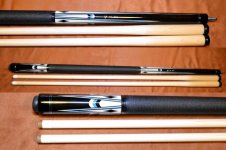justinb386
Banned
Are most Philippine cues made with real inlays, or do some use decals?
Is it easy to tell the difference?
Can anyone most any pictures of a Philippine made cue that was made using decals, and not real inlays?
I always wondered how these Philippine cue makers were able to make such fancy looking cues for so cheap.
I mean if they are using real inlays, then it must have taken them a very long time for all of the fancy inlays work (even thought it may not be perfect inlay work, like a lot of american cue makers cues).
If there are decal cues from the Philippines, then I am very curious to know how I would be able to tell the difference from just pictures of the cue.
Thanks.
Is it easy to tell the difference?
Can anyone most any pictures of a Philippine made cue that was made using decals, and not real inlays?
I always wondered how these Philippine cue makers were able to make such fancy looking cues for so cheap.
I mean if they are using real inlays, then it must have taken them a very long time for all of the fancy inlays work (even thought it may not be perfect inlay work, like a lot of american cue makers cues).
If there are decal cues from the Philippines, then I am very curious to know how I would be able to tell the difference from just pictures of the cue.
Thanks.
